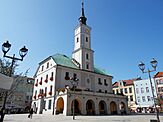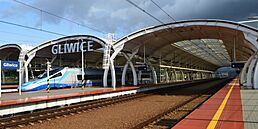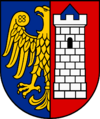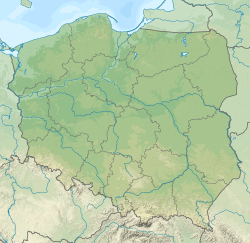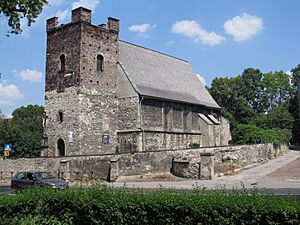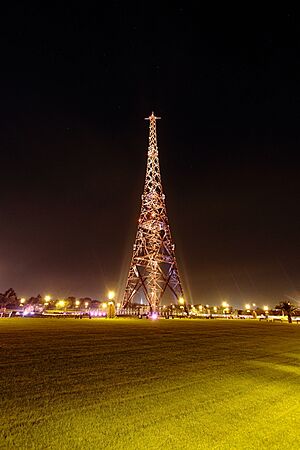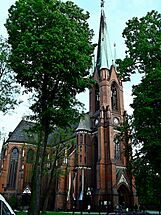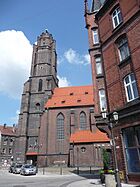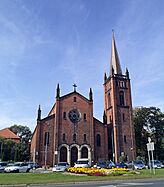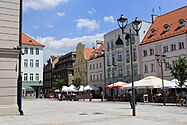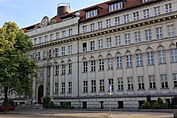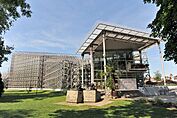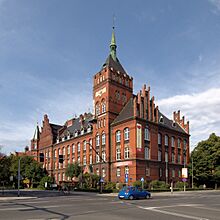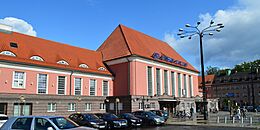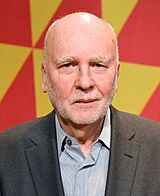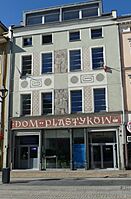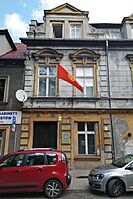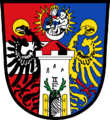Gliwice facts for kids
Quick facts for kids
Gliwice
|
|||
|---|---|---|---|
|
|||
|
|||
| Country | |||
| Voivodeship | |||
| County | city county | ||
| Established | 13th century | ||
| City rights | 1250 | ||
| Area | |||
| • City | 134.2 km2 (51.8 sq mi) | ||
| Highest elevation | 278 m (912 ft) | ||
| Lowest elevation | 200 m (700 ft) | ||
| Population
(31 December 2021)
|
|||
| • City | 175,102 |
||
| • Density | 1,330/km2 (3,400/sq mi) | ||
| • Urban | 2,746,000 | ||
| • Metro | 4,620,624 | ||
| Time zone | UTC+1 (CET) | ||
| • Summer (DST) | UTC+2 (CEST) | ||
| Postal code |
44-100 to 44-164
|
||
| Area code(s) | +48 32 | ||
| Car plates | SG | ||
| Climate | Cfb | ||
| Primary airport | Katowice Airport | ||
| Highways | |||
| Website | http://www.gliwice.eu/ | ||
Gliwice (pronounced ghee-LEE-vee-tseh) is a city in southern Poland, located in a region called Upper Silesia. It sits on the Kłodnica river, which flows into the Oder River. Gliwice is about 25 kilometers (15 miles) west of Katowice, the main city of the Silesian Voivodeship region.
Gliwice is part of a large urban area called Metropolis GZM, home to 2 million people. It's the third-largest city in this area, with about 175,000 residents as of 2021. Gliwice is also part of the bigger Katowice-Ostrava metropolitan area, which has about 5.3 million people and stretches into the Czech Republic. The city is surrounded by other towns like Zabrze, Knurów, and Pyskowice.
Gliwice is known as a major college town in Poland. The Silesian University of Technology, founded in 1945, attracts over 20,000 students. The city is also an important industrial hub. After changes in the 1990s, Gliwice moved away from steelworks and coal mining to focus on the automotive and machine industry.
Founded in the 13th century, Gliwice has a well-preserved Old Town. Some of its oldest buildings include St Bartholomew's Church (15th century), Gliwice Castle (14th century), and All Saints Old Town Church (15th century). Gliwice is famous for its Gliwice Radio Tower, which is believed to be the world's tallest wooden structure. A significant event called the Gleiwitz incident happened there just before World War II. Gliwice also hosted the Junior Eurovision Song Contest 2019.
Contents
The Name of Gliwice
The name Gliwice comes from old Slavic languages. The root words gliw or gliv suggest an area with loam (a type of soil) or wetland. In some South Slavic languages, glive or gljive means mushrooms, so gljivice means "little mushrooms."
History of Gliwice
Early Beginnings
Gliwice was first mentioned as a town in 1276. However, it received its town rights even earlier, around 1250, from Duke Władysław Opolski of the Piast dynasty. The town was important because it was on a trade route between Kraków and Wrocław. Over the centuries, it was part of different Polish duchies ruled by the Piast family.
In 1335, Gliwice came under the rule of the Lands of the Bohemian Crown. Later, in 1526, it became part of the Austrian Habsburg Empire. In the Middle Ages, Gliwice grew thanks to trade and crafts, especially brewing beer.
From the 1600s to the 1800s
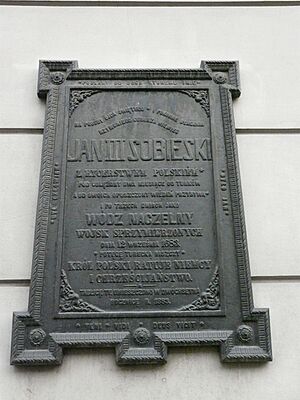
After 1532, Gliwice became part of the Habsburg monarchy. The city was leased out to a private owner for a long time due to the Habsburgs' wars. Around 1612, a monastery and church were built. Gliwice was affected by the Thirty Years' War, being attacked or captured by different armies. In 1645, it returned to Polish rule for a while, but then fell to Austria again in 1666. In 1683, Polish King John III Sobieski visited the city before the famous Battle of Vienna. In the 17th and 18th centuries, the city's economy changed from trade and brewing to making cloth.
In the mid-18th century, Gliwice was taken from the Habsburgs by the Kingdom of Prussia during the Silesian Wars. In 1871, it became part of the German Empire.
Industrial Growth and the 20th Century
The first coke-fired blast furnace in Europe was built in Gliwice in 1796. This helped Gliwice become a major industrial city in the 19th century. The city's ironworks led to the growth of other industries. By the late 1800s, Gliwice had many factories, including distilleries, breweries, brick factories, and glassworks.
The city also developed its infrastructure, with a tram system in 1892 and a theater in 1899. Despite efforts to make Poles speak German, local Poles created their own organizations and newspapers.
After World War I, there were conflicts between Poles and Germans in Silesia. Many Poles wanted Gliwice to join the newly independent Second Polish Republic. A vote was held in 1921 to decide which country the city would belong to. Most people in Gliwice voted to stay with Germany. So, Gliwice remained in Germany, but it was very close to the border with Poland.
During the time between the World Wars, Polish people in Gliwice faced difficulties. Polish activists were increasingly treated unfairly starting in 1937.
The Gleiwitz incident happened on August 31, 1939, at the Gliwice radio station. It was a "false-flag attack" staged by Germany to create an excuse to invade Poland. This invasion marked the beginning of World War II. During the war, Germans set up many forced labor camps in Gliwice, including subcamps of the Auschwitz concentration camp. Many prisoners died from hunger, mistreatment, or murder. There are mass graves in the city for victims of the death march from Auschwitz in early 1945.
On January 24, 1945, the Red Army took over Gliwice. After Germany's defeat, the city became part of Poland again on March 18, 1945. In 1956, people in Gliwice showed support for the Hungarian Revolution of 1956 by raising money and donating blood.
People of Gliwice
Population Changes
Gliwice's population has changed a lot over time. In 1750, there were only about 1,159 people. By 1861, it had grown to over 10,000. The city saw fast growth during the Industrial Revolution. In 1927, Gliwice became a "large city" when its population reached over 100,000.
In 1945, many residents left the city as the Red Army approached. After the war, Gliwice became part of Poland. Many Germans who remained were moved out, and Poles, including those who had been moved from eastern Poland, settled in Gliwice. The population reached its highest point in 1988 with over 223,000 people. Since then, the population has slowly decreased due to lower birth rates and people moving to nearby suburbs.
Background and Languages
Historically, Gliwice was a mix of different cultures. It was first settled by Poles, but later had a German majority due to German settlement. However, a significant number of Poles always lived there. After World War II, most Germans left or were moved, and Poles became the main group. Many new residents came from other parts of Poland, including academics who helped create the Silesian University of Technology.
Today, most people in Gliwice identify as Polish. The most common language spoken at home is Polish. Some people also speak Silesian or German.
Faith and Beliefs
For most of its history, Gliwice has had a Catholic majority, with smaller groups of Protestants and Jews. In 1861, about 68% of the people were Catholic, 14% Protestant, and 17% Jewish.
Today, most residents are Catholic. There are also other religious groups, including Jehovah's Witnesses and Protestants. Gliwice is the main city for the Roman Catholic Diocese of Gliwice. It also has one of Poland's three Armenian Church parishes.
Jewish Community in Gliwice
The Jewish population in Gliwice was largest around 1929, with about 2,200 people. However, this number began to drop in the late 1930s as the Nazi Party came to power in Germany. By 1939, the number had fallen by half due to people leaving the country. The New Synagogue was destroyed in 1938 during a Nazi attack known as Kristallnacht. During the Holocaust, many Jews from Gliwice were sent to Auschwitz-Birkenau.
Only about 25 Jews from Gliwice's pre-war community survived World War II in the city. After the war, Gliwice became a gathering point for Holocaust survivors, and the Jewish population grew to about 1,000 in 1945. Since then, the number has decreased as survivors moved to larger cities or other countries like Israel and the United States. Today, Gliwice has a small Jewish community of about 25 people. There is a Jewish prayer house in the city where services are held.
Places to See and Buildings
- Market Square (Rynek) is in the Old Town. It has the Town Hall (Ratusz), a Neptune Fountain, and colorful historic buildings.
- The Gliwice Radio Tower in Szobiszowice is unique because it's the only remaining radio tower in the world made of wood. At 118 meters (387 feet) tall, it might be the tallest wooden structure in the world. It's now a branch of the local museum.
- Piast Castle dates back to the Middle Ages and also houses a part of the local museum.
- Museum in Gliwice (Muzeum w Gliwicach) is the city's main museum.
- Sts. Peter and Paul Cathedral is the main church of the Catholic Diocese of Gliwice. There are also other historic churches.
- Medieval fortified Old Saint Bartholomew church is one of the oldest buildings in Gliwice.
- Medieval town walls can still be seen.
- Baroque Holy Cross Church and a monastery from the 17th century.
- Piłsudski Square has a monument to the Polish leader Józef Piłsudski.
- Chopin Park has a monument to the Polish composer Fryderyk Chopin and the Municipal Palm House.
- Culture and Recreation Park in Gliwice is a great place for outdoor activities.
- Many historic public buildings, like the Main Post Office and the district court.
- Teatr Miejski (Municipal Theatre) is the city's theater.
- Chrobry Park and Mickiewicz Square with a monument to Adam Mickiewicz.
- Gliwice Trynek narrow-gauge station is a protected historical site.
- The Weichmann Textile House was built in 1921-1922. It was designed by the famous architect Erich Mendelsohn. It was originally a silk shop owned by Erwin Weichmann. Today, it's a bank, and there's a monument near the entrance.
Learning and Science in Gliwice
Gliwice is an important center for applied science in the Metropolis GZM. It is home to:
- Silesian University of Technology with about 32,000 students.
- Branches of other universities like Akademia Polonijna and WSB University.
- Polish Academy of Sciences has several research institutes here, focusing on computer science, chemical engineering, and carbochemistry.
- Other research centers for topics like oncology, inorganic chemistry, and welding.
Getting Around Gliwice
Major highways run through Gliwice, including the Polish north-south A1 and east-west A4 motorways. These are part of larger European routes. Other national roads also pass through the city.
Waterways
The Gliwice Canal (Kanał Gliwicki) connects the city's harbor to the Oder River. This allows boats to travel to other parts of Germany and even to the Baltic Sea. There's also an older canal, the Kłodnica Canal, but it's no longer used.
Sports in Gliwice
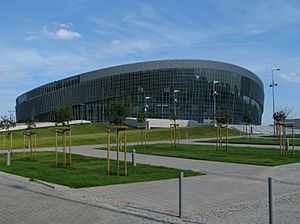
| Club | Sport | League | Trophies |
|---|---|---|---|
| Piast Gliwice | Men's football | Ekstraklasa | 1 Polish Championship (2019) |
| Piast Gliwice | Men's futsal | Ekstraklasa | 1 Polish Championship (2022) |
| GTK Gliwice | Men's basketball | Polish Basketball League | 0 |
| Sośnica Gliwice | Women's handball | Liga Centralna Kobiet | 3 Polish Championships 3 Polish Cups |
Other sports clubs in Gliwice include the Gliwice Cricket Club, K.S. Kodokan Gliwice (martial arts), and Gliwice LIONS (American Football).
Famous People from Gliwice
Many notable people were born or lived in Gliwice, including:
- John Baildon (1772–1846), a Scottish engineer.
- Horst Bienek (1930–1990), a German author.
- Sebastian Boenisch (born 1987), a Polish-German football player.
- Jerzy Buzek (born 1940), a professor of chemistry, former Prime Minister of Poland, and former president of the European Parliament. His daughter, Agata Buzek, is a Polish actress.
- Eugen Goldstein (1850–1930), a German physicist.
- Włodzimierz Lubański (born 1947), a Polish football player.
- Lukas Podolski (born 1985), a Polish-German football player.
- Wojciech Pszoniak (1942–2020), a Polish actor.
- Tadeusz Różewicz (1921–2014), a Polish poet and writer.
- Oscar Troplowitz (1863–1918), a German pharmacist and inventor of Nivea cream.
- Adam Zagajewski (1945–2021), a Polish poet.
- Krystian Zimerman (born 1956), a Polish pianist and conductor.
International Connections
Consulates
Gliwice hosts honorary consulates for Germany, Kyrgyzstan, and Slovakia.
Twin Towns – Sister Cities
Gliwice is connected with several cities around the world:
 Bottrop, Germany
Bottrop, Germany Dessau-Roßlau, Germany
Dessau-Roßlau, Germany Doncaster, England, United Kingdom
Doncaster, England, United Kingdom Kežmarok, Slovakia
Kežmarok, Slovakia Nacka, Sweden
Nacka, Sweden Salgótarján, Hungary
Salgótarján, Hungary Valenciennes, France
Valenciennes, France
Images for kids
See also
 In Spanish: Gliwice para niños
In Spanish: Gliwice para niños


